
The East Village is a neighborhood on the East Side of Lower Manhattan in New York City. It is roughly defined as the area east of the Bowery and Third Avenue, between 14th Street on the north and Houston Street on the south. The East Village contains three subsections: Alphabet City, in reference to the single-letter-named avenues that are located to the east of First Avenue; Little Ukraine, near Second Avenue and 6th and 7th Streets; and the Bowery, located around the street of the same name.

Urban renewal is a program of land redevelopment often used to address urban decay in cities. Urban renewal involves the clearing out of blighted areas in inner cities to clear out slums and create opportunities for higher class housing, businesses, and other developments.
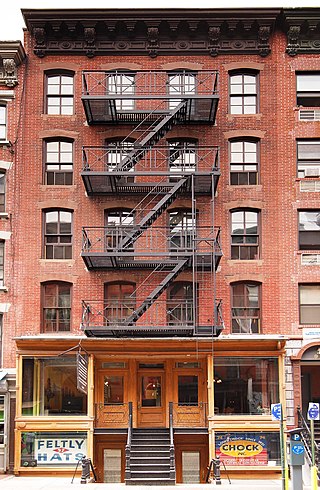
The Lower East Side Tenement Museum, located at 97 and 103 Orchard Street in the Lower East Side neighborhood of Manhattan, New York City, is a National Historic Site. The museum's two historical tenement buildings were home to an estimated 15,000 people, from over 20 nations, between 1863 and 2011. The museum, which includes a visitors' center, promotes tolerance and historical perspective on the immigrant experience.
Manhattantown, now known as Park West Village or West Park Apartments, was a massive urban renewal project in New York City's Manhattan Valley neighborhood. The project, which stretched between West 96th and West 100th streets, bordering Central Park West, was funded by Title I of the Housing Act of 1949, which financed slum clearance under urban redevelopment initiatives. Allegations of corruption were leveled soon after the project's inception in the spring of 1949, culminating in hearings in the Senate's Banking and Currency Committee in 1954.

Penn South, officially known as Mutual Redevelopment Houses and formerly Penn Station South, is a limited-equity housing cooperative development located between Eighth and Ninth Avenues and West 23rd and 29th Streets, in the Chelsea neighborhood of Manhattan, New York City. The complex has 2,820 units in ten 22-story buildings. Penn South is so named because of its location southwest of New York Penn Station.

Knickerbocker Village Limited is a housing development situated between the Manhattan Bridge and Brooklyn Bridge, in the Two Bridges section of the Lower East Side of Manhattan, New York City. Although the location was generally considered to fall in the Lower East Side, it has come to be thought of as part of Chinatown in recent years and the majority of residents are Chinese. It is located a short distance from New York City Hall, Civic Center, and the South Street Seaport. The complex consists of 1,590 apartments in twelve 13-story brick buildings surrounding two courtyards at 10-12-14-16-18-20 Monroe Street and 30-32-34-36-38-40 Monroe Street on the Lower East Side, taking up two whole city blocks and bounded by Catherine Street, Monroe Street, Market Street, and Cherry Street. Knickerboker Village is in ZIP Code 10002.
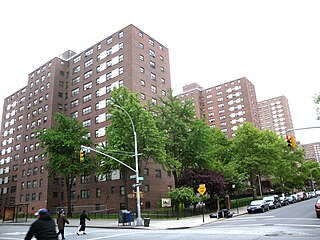
The Frederick Douglass Houses are a public housing project located in the New York City borough of Manhattan, in the Manhattan Valley neighborhood of Upper West Side, named for civil rights pioneer Frederick Douglass. The actual buildings are located between 100th Street and 104th Street, to the east of Amsterdam Avenue and the west of Manhattan Avenue. The complex is owned and operated by the New York City Housing Authority.

The Boulevard Gardens Apartments is a 960-unit apartment complex at 54th Street and 31st Avenue in Woodside, Queens, New York City. It opened in June 1935, during the Great Depression. They were designed by architect Theodore H. Englehardt for the Cord Meyer Development Corporation; the design was based on an apartment complex Elgelhardt designed in Forest Hills.
Kennedy Park is a neighborhood in East Bayside in downtown Portland, Maine, built around a park, athletic fields, basketball courts, a playground and the Boyd Street Urban Garden.

St. Nicholas Houses or "Saint Nick," is a public housing project in Central Harlem, in the borough of Manhattan, New York City and are managed by the New York City Housing Authority (NYCHA). The project is located between Adam Clayton Powell Jr. Boulevard and Frederick Douglass Boulevard, spanning a superblock from 127th Street to 131st Street. The project consists of thirteen 14-story buildings containing 1,523 apartment units.
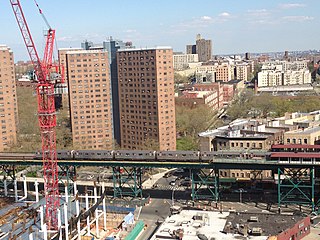
Manhattanville Houses is a public housing project in the Manhattanville section of West Harlem, in the borough of Manhattan, New York City. The project is located between Broadway and Amsterdam Avenue, spanning a superblock from 129th Street to 133rd Street and is managed by the New York City Housing Authority. The project consists of six 20-story buildings containing 1,272 apartment units.

General Ulysses S. Grant Houses or Grant Houses is a public housing project at the northern boundary of Morningside Heights in the borough of Manhattan, New York City. The complex consists of 10 buildings with over 1,940 apartment units on 15.05-acres and is located between Broadway and Morningside Avenue, spanning oddly shaped superblocks from 123rd Street and La Salle Street to 125th Street. The development was named after Ulysses S. Grant (1822-1885), a Civil War Union army general and the 18th President of the United States.

The Stanley M. Isaacs Houses is a public housing project for those of low-to-moderate incomes located just south of 96th street in the Manhattan neighborhood of Yorkville. The Isaacs Houses and the Holmes Towers borders East Harlem, which has the second highest concentration of public housing in the New York City. The three public housing buildings in the Yorkville neighborhood of Manhattan in New York City, are 24 stories tall and contain 635 apartments. The project is located between 93rd and 95th Streets with playground & ball courts from 95th-97th street, stretching from 1st Avenue to the FDR Drive.
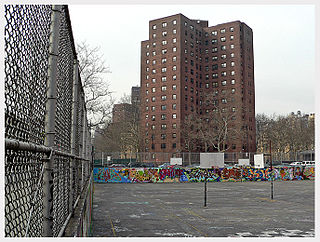
Carver Houses, or George Washington Carver Houses, is a public housing development built and maintained by the New York City Housing Authority (NYCHA) in Spanish Harlem, a neighborhood of Manhattan.
Governor DeWitt Clinton Houses, also known as DeWitt Clinton Houses or Clinton Houses, is a public housing development built and maintained by the New York City Housing Authority (NYCHA) in the Spanish Harlem neighborhood of Manhattan. Clinton Houses is composed of six buildings, resting on a non-continuous campus with an area of 5.6 acres (23,000 m2). Five of those (I-V) are 18 stories high, and another (VI) is nine stories high. The six buildings have a total of 749 apartments, which house 1,823 people. Clinton Houses occupies the two blocks that are bordered by East 110th Street to the north, Lexington Avenue to the east, Park Avenue to the west, and East 108th Street to the south. It also occupies the western half of the two blocks that are bordered by East 106th Street to the north, Lexington Avenue to the east, Park Avenue to the west, and East 104th Street to the south, with the exception of a small part along East 106th Street.
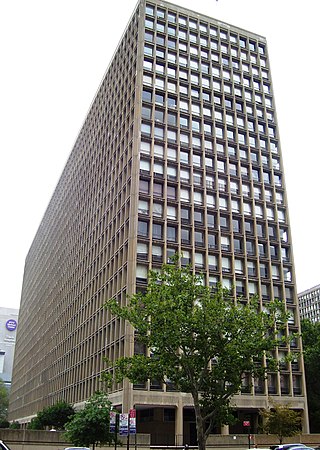
Kips Bay Towers is a large two-building condominium complex in the Kips Bay neighborhood of Manhattan with a total of 1,118 units. The complex was designed by architects I.M. Pei and S. J. Kessler, with the involvement of James Ingo Freed, in the brutalist style and completed in 1965. The project was developed by Webb & Knapp.

South Jamaica Houses is a housing project in South Jamaica, Queens, New York. It is nicknamed "40 Projects." The original complex, South Jamaica I Houses opened in 1940, while the second complex, South Jamaica II Houses, opened in 1954. The entire complex is bounded by South Road to the north, 160th Street to the east, Brinkerhoff Avenue to the south, and 158th Street to the west.
The Forest Houses are a housing project in Morrisania, Bronx. The project consists of fifteen buildings, 9, 10 and 14-stories tall with 1,350 apartment units. It covers a 17.72-acre expanse, and is bordered by East 163rd and East 166th Streets, and Trinity and Tinton Avenues. It is owned and managed by New York City Housing Authority (NYCHA).

San Juan Hill was a community in what is now the Lincoln Square neighborhood of the Upper West Side in Manhattan, New York City. Its residents were mostly African-American, Afro-Caribbean, and Puerto Rican, and comprised one of the largest African-American communities in New York before World War I. San Juan Hill was bound by 59th Street to the south, West End Avenue to the west, 65th Street to the north, and Amsterdam Avenue to the east. The site is now occupied by Lincoln Center, a 16.3-acre (6.6 ha) complex dedicated to the performing arts.
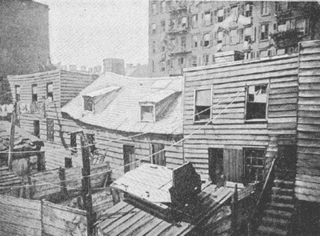
Slum clearance in the United States has been used as an urban renewal strategy to regenerate derelict or run-down districts, often to be replaced with alternative developments or new housing. Early calls were made during the 19th century, although mass slum clearance did not occur until after World War II with the introduction of the Housing Act of 1949 which offered federal subsidies towards redevelopments. The scheme ended in 1974 having driven over 2,000 projects with costs in excess of $50 billion.






















